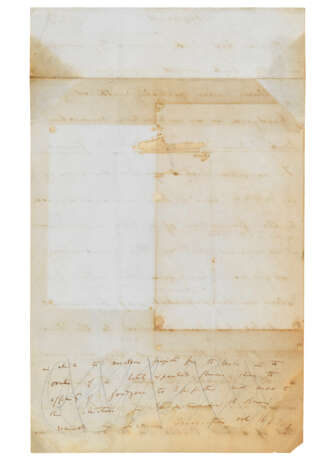ID 870736
Lot 54 | DARWIN, Charles (1809-1882)
Estimate value
£ 5 000 – 8 000
Manuscript draft with autograph annotations for On the various contrivances by which British and foreign orchids are fertilised by insects and on the good effects of intercrossing [c.1861-62].
1 1/2 pages, 327 x 201mm (verso text cancelled in pencil by Charles Darwin, water staining affecting the bottom two inches of the leaf though not affecting legibility). Provenance: Henrietta Litchfield (1843-1927), Darwin's daughter; a letter dated 31 July [18]92 identifies her father's hand and asks to be remembered to Monsieur Fournier [also referencing the following lot].
A draft leaf for Darwin’s 1862 ‘Orchid book’, showing variation from the published text; presented to the recipient by Darwin's daughter Henrietta Litchfield. The text on the recto in the hand of an amanuensis for pp. 114-115 of On the various contrivances…, opening ‘…the pollinia had been removed by insects’ and closing ‘In the rostellum being supported…’ with three interlinear annotations in Darwin’s hand (line 8: ‘*a’; line 9: ‘like that in the Ophreæ; and’; and line 11: ‘likewise as in the Ophreæ’). The verso with 5 lines in Darwin’s hand: ‘in which the nucleus projects from the testa in the ovules of a lately expanded flower shows the affinity of Goodyera to Epipactis. With respect to this structure in Epipactis see R. Brown’s remarks in Linnean Transactions vol. 16 p.703’.
The cross-fertilisation of flowers had intrigued Darwin for many years before the publication in 1862 of his ‘Orchid book’, as he more referred to On the various contrivances by which British and foreign orchids are fertilised by insects and on the good effects of intercrossing; he traced his interest in the mechanism back to the summer of 1838 in his Autobiography, ‘from having come to the conclusion in my speculations on the origin of species, that crossing played an important part in keeping specific forms constant’. Darwin returned time and again to the study of orchids in the latter half of the 1850s before his monumental effort to bring the Origin of Species to print in 1859 eclipsed all other projects: after its publication, he intended to turn immediately to preparatory work for Variation [published 1868], but was much distracted from his larger work by his admiration for the orchid (he wrote in a 19 June 1860 letter to Hooker: ‘Have pity on me & let me write once again on Orchids for I am in a transport of admiration at most simple contrivance, & which I shd. so like you to admire’). The first draft of what was intended only to be a paper on orchids was completed in the summer of 1861, during a two-month trip to Torquay; unable to resist adding further pages across the following months, Darwin soon had the material for a book, the manuscript for which he completed in March 1862. The draft text on the recto for pp.114-115 diverges slightly from the published version (see ‘fork-shaped margins’ versus ‘fork-shaped supporting sides’ in print) and Darwin’s autograph annotation on the verso does not appear in the published text, which points to an earlier stage in the process of drafting the ‘Orchid book’.
Apparently unpublished.
Special notice
This lot has been imported from outside of the UK for sale and placed under the Temporary Admission regime. Import VAT is payable at 5% on the hammer price. VAT at 20% will be added to the buyer’s premium but will not be shown separately on our invoice.
| Place of origin: | Northern Europe, Europe, United Kingdom |
|---|---|
| Auction house category: | Letters, documents and manuscripts |
| Place of origin: | Northern Europe, Europe, United Kingdom |
|---|---|
| Auction house category: | Letters, documents and manuscripts |
| Address of auction |
CHRISTIE'S 8 King Street, St. James's SW1Y 6QT London United Kingdom | |
|---|---|---|
| Preview |
| |
| Phone | +44 (0)20 7839 9060 | |
| Buyer Premium | see on Website | |
| Conditions of purchase | Conditions of purchase |






